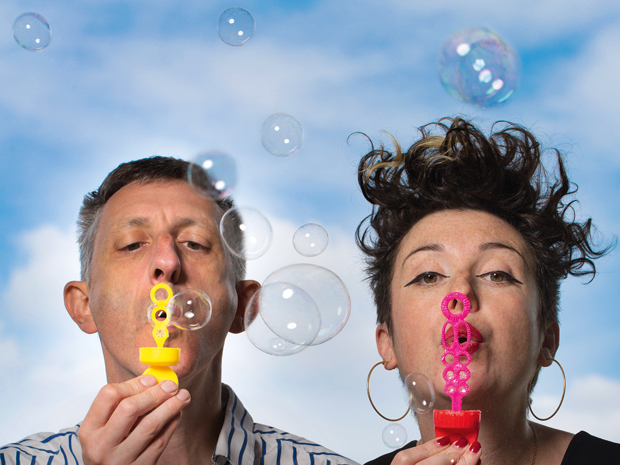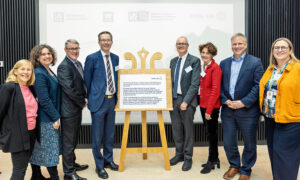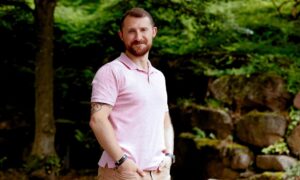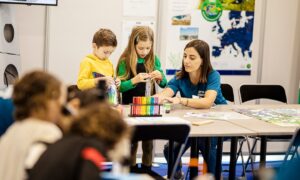
Music of the spheres
Science and art are often considered opposites – so what happens when practitioners in each field collaborate? The results can be spectacular…

They seem an unlikely pair: Charlotte Jarvis, adorned in the flowing black symbolic of artists, with boldly lined eyes and curly dark hair standing impossibly straight up from her head as if she had just emerged from a lightning storm; and Nick Goldman, a lanky bioinformatician, going gracefully grey, wearing chinos and a button-down shirt and sporting the perpetually rumpled look of a man whose mind moves much faster than his body. Despite their mismatched appearance, the artist and the scientist share a common passion for a very unusual type of storage medium – DNA – and are putting their heads together to create a unique art project involving bioinformatics, music and soap bubbles.
They met in 2012 when one of Goldman’s colleagues at EMBL-EBI happened to see a flyer for an exhibition of Jarvis’s previous art project, in which she collaborated with the Netherlands Proteomics Centre in Utrecht to encode the Universal Declaration of Human Rights into the DNA of a bioengineered bacterium. Goldman immediately spotted that Jarvis had done something very similar to a project he was working on: inventing a code to enable information to be stored in sequences of DNA. Goldman’s method essentially uses synthetic DNA as a kind of hard drive, allowing diverse types of data like music recordings, images and documents to be saved and ‘read’ via DNA sequencing.
Goldman went to the opening and met Jarvis, and their mutual excitement about the implications of the technology created an instant connection. “Charlotte was very enthusiastic when I told her that it was possible to store any information, not just text, in DNA,” says Goldman. “When I realised the scope of what you can do with that technology, it just completely blew my mind,” Jarvis agrees. She asked Goldman to collaborate with her on a new initiative using his method of encoding data into DNA, and their interdisciplinary project was born.
Music in all things
When deciding what kind of information she wanted to store in DNA, Jarvis was inspired by a snippet of verse from Lord Byron’s epic poem Don Juan:
There’s music in the sighing of a reed;
There’s music in the gushing of a rill;
There’s music in all things, if men had ears;
The earth is but the music of the spheres.
“It really sums up my understanding of DNA: it’s in all living things, it underpins life on our planet, it’s kind of vibrating through everything,” she says. “And I see some similarities between DNA and music: they’re both quite fundamental, they’re both quite abstract, they’re invisible but they can be everywhere… so I decided that I wanted it to be musical.”
Invigorated, Jarvis enlisted British composer Mira Calix to write an original piece of music that would be recorded and stored in DNA. Calix used the harmonic hum of the machines in the server room at EMBL-EBI – home to the world’s most comprehensive collection of genetic databases – as inspiration. “It has the most incredible sound,” says Jarvis, still awestruck by the recollection. “It’s so loud that the people who work there have to wear ear protectors. It just hits you like a wall, the sound of all that genetic data being stored, all those ones and zeros that define life.” But music is a living thing, not just fodder for the archives. Jarvis wanted to find a way to make the project more interactive, and to somehow convey the sense of wonder that she feels when considering just how much significance is contained within such a tiny molecule. Harking back to Byron’s ‘music of the spheres’, she settled on the idea of infusing the DNA into bottles of soap bubbles, so that any bubbles blown will become spheres of musical DNA floating through the air.
From music to bubbles – and back
1. Jarvis enlists British composer Mira Calix to write an original piece of music – she does this, inspired by the hum of the huge data storage machines in the server room at EMBL-EBI.
2. The music is recorded and encoded in a form that could be represented by the letters of DNA. That DNA was then synthesised and infused into liquid soap.
3. Calix’s music is performed on stage by an orchestra. Bubbles of the DNA-infused soap will be blown about during the performance, filling the air with miniscule copies of the original composition.

4. As the bubbles float through the air, the musicians fall silent. The bubbles become the only physical manifestation of the music.
5. After the performance, the soap mixture is offered to audience members as they leave. Theoretically, they could have the soap sequenced, whereupon a digital file detailing the sequence of the DNA fragments would be sent to them.
6. Then, using instructions online and some smart computer programming, they can decode the fragments to recreate the music file.
The debut performance of Calix’s musical composition is set for early 2015, and machines will fill the air with DNA bubbles at a specified point in the piece when the musicians fall silent, so that the music will only exist in the form of DNA. “We are going to fill the air with Mira’s music, and then they can spread the composition on their skin, or later take a bottle home, mix it in their bath, do whatever they want with it,” says Jarvis.
If some members of the audience want to actually listen to this section of the music, they can extract the DNA, sequence it, and then decode it using Goldman’s method. The final piece of the project is a film of the musicians playing Calix’s music in the EMBL-EBI server room. The film will be shown at exhibitions that Jarvis has planned for 2015. “It’s definitely the most ambitious project I’ve ever been involved with,” she says, “and there are still a lot of exciting things to come.”
A two-way street
This is Goldman’s first time embarking on a project that appeals to an audience with such a broad range of interests, and he is enjoying rubbing shoulders with the art world. “I find Charlotte really impressive,” he says. “She’s a bona fide artist, she’s genuinely enthusiastic about science, and she wants to talk to people about it. That approach fits really well with my responsibilities as a scientist: not just doing science, but getting it out to the public.”
Science and technology are changing our own bodies, our own identities, and our perception of the world. I think it’s completely natural that artists would want to engage with that.
Jarvis has been collaborating with scientists for five years, and has seen the ‘science art’ community expand a lot during that time. She finds it natural that artists would want to work with scientists. “As an artist, you make art about the things that inspire you and the things that are changing the world,” she says. “Science and technology are having the most incredible and important impact on our planet today, and not only in a physical sense; they’re changing our own bodies, our own identities, and our perception of the world. I think it’s completely natural that artists would want to engage with that.”
The relationship goes both ways: scientists reach out to the arts both for inspiration and to get a more diverse mix of people interested in their work. For example, Sarah Teichmann, a group leader at EMBL-EBI and the Sanger Institute, recently collaborated with a composer on a musical project based on a 20-page printout of DNA sequences from the 1000 Genomes Project.
Jarvis thinks that this trend is driven in part by an increased emphasis on communication within the research world. Artists, she says, can help scientists reach a larger audience by translating their work into formats that are easier for the public to engage with and understand. “Rather than focusing on what exactly a technology does or what the end point will be, artists are quite good at looking at things tangentially. Their responses are more likely to be, ‘Look at all these possibilities! Look at all the different ways we can interact with these results, question them, pick them apart and put them back together! Look how beautiful this can be!’ So in that sense, artists can really offer something beyond what scientists are being forced to focus on.”

“People experience lots of pressure to do just one area of science,” Goldman agrees, adding that scientists need so much specialised knowledge to make progress that there is often little time to think about how to disseminate their work beyond the research community. But, he says, “There are lots of times when thinking through things in a different way gives you inspiration in your science. I could imagine sitting down with Charlotte and hearing her say ‘Oh, it would be so much better if we could do this or that with DNA,’ and then a minute or a day later I’d think, ‘Actually, you could do that thing she wants with DNA,’ and then we could both use that advancement in our own careers.”
Arts and sciences: a natural fit
Goldman is taking full advantage of this chance to explore and promote science in different ways, because he knows it’s a luxury few researchers have. “I’m lucky to have a job where I’m allowed to spend part of my time with an artist. Charlotte and I get on great – she drags me to some of the art events where she’s pitching for funding or promoting the project, and I do the sciencey bit. I’m a bit of a pet scientist,” he jokes, with a good-natured laugh. “And I would have no fear about her giving a talk at one of EMBL-EBI’s events. I expect that there will be more of these kinds of collaborations across the sciences in the future. It’s certainly been good for Charlotte and myself, and for EMBL.


